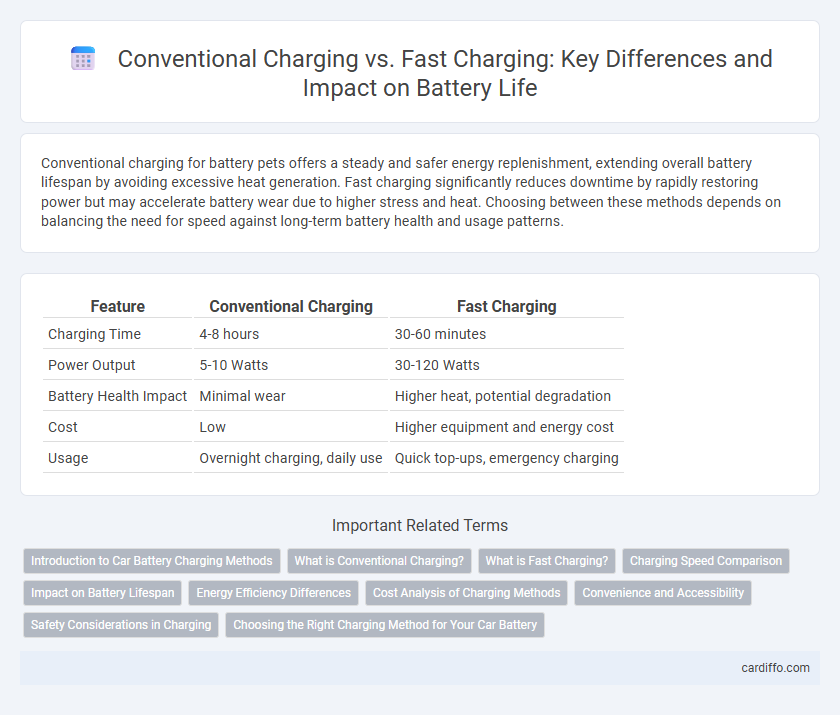Conventional charging for battery pets offers a steady and safer energy replenishment, extending overall battery lifespan by avoiding excessive heat generation. Fast charging significantly reduces downtime by rapidly restoring power but may accelerate battery wear due to higher stress and heat. Choosing between these methods depends on balancing the need for speed against long-term battery health and usage patterns.
Table of Comparison
| Feature | Conventional Charging | Fast Charging |
|---|---|---|
| Charging Time | 4-8 hours | 30-60 minutes |
| Power Output | 5-10 Watts | 30-120 Watts |
| Battery Health Impact | Minimal wear | Higher heat, potential degradation |
| Cost | Low | Higher equipment and energy cost |
| Usage | Overnight charging, daily use | Quick top-ups, emergency charging |
Introduction to Car Battery Charging Methods
Conventional car battery charging typically uses a low amperage over several hours to replenish energy safely, preserving battery lifespan. Fast charging employs higher currents to rapidly restore charge within minutes, optimizing convenience but potentially accelerating battery wear. Understanding these methods helps balance charging speed with long-term battery health for electric vehicle owners.
What is Conventional Charging?
Conventional charging refers to the standard method of charging a battery at a lower current over a longer period, typically using a charger with a power output between 5 to 10 watts. This method helps maintain battery health by reducing heat generation and minimizing stress on lithium-ion cells, leading to longer battery lifespan. Conventional charging is commonly used overnight or during extended idle times to ensure a full charge without compromising battery durability.
What is Fast Charging?
Fast charging is a technology designed to rapidly replenish a battery's energy by increasing the power output beyond conventional charging limits, often delivering up to 50% charge in 30 minutes or less. It employs advanced chargers and battery management systems that regulate temperature and voltage to ensure safety and efficiency. This method significantly reduces downtime, making it ideal for electric vehicles, smartphones, and other portable devices requiring quick power top-ups.
Charging Speed Comparison
Conventional charging typically delivers power at 5 to 10 watts, fully charging batteries in 3 to 5 hours, while fast charging technology can provide 50 to 350 watts or more, reducing charging time to under an hour for compatible devices. Fast charging relies on advanced battery management systems and higher current flow, which can generate heat and impact battery lifespan if not properly managed. The efficiency of charging speed also depends on battery capacity, charger output, and thermal regulation mechanisms integrated within the battery design.
Impact on Battery Lifespan
Conventional charging, typically at 0.5C to 1C rates, promotes longer battery lifespan by minimizing internal stress and heat generation, preserving electrode integrity over thousands of cycles. Fast charging, often exceeding 2C rates, accelerates degradation mechanisms such as lithium plating and SEI layer breakdown, reducing overall battery lifespan by 20-30%. Optimal battery management systems balance charge speed and thermal control to mitigate fast charging impacts while maintaining practical recharge times.
Energy Efficiency Differences
Conventional charging typically offers higher energy efficiency by minimizing heat generation and reducing energy loss during the slower charging process. Fast charging increases power delivery, accelerating battery refill but often results in greater heat production and energy dissipation, lowering overall efficiency. Optimization of charging protocols and battery thermal management can help mitigate energy losses in fast charging systems.
Cost Analysis of Charging Methods
Conventional charging typically incurs lower initial infrastructure costs but results in higher long-term expenses due to prolonged energy consumption and inefficiency. Fast charging demands significant investment in advanced technology and higher electricity rates, yet it reduces overall operational downtime and labor costs. Evaluating total cost of ownership reveals that fast charging offers better economic value for commercial and high-usage applications, whereas conventional charging suits low-frequency or residential use.
Convenience and Accessibility
Conventional charging offers widespread accessibility due to its compatibility with standard outlets, making it convenient for everyday use in homes and offices. Fast charging significantly reduces wait times by delivering higher power levels, which enhances convenience for users needing quick battery replenishment. Availability of fast chargers is increasing in public spaces, improving accessibility but still trailing conventional chargers in ubiquity.
Safety Considerations in Charging
Conventional charging typically uses lower current levels, reducing the risk of overheating and thermal runaway, which enhances battery safety during the charging process. Fast charging involves higher currents and voltages that can accelerate battery degradation and increase the likelihood of safety hazards such as electrolyte leakage or internal short circuits. Implementing robust battery management systems (BMS) and thermal regulation is critical to maintaining safety standards in both conventional and fast charging scenarios.
Choosing the Right Charging Method for Your Car Battery
Choosing the right charging method for your car battery depends on the battery type, driving habits, and time availability. Conventional charging provides a slow, steady charge that helps maintain battery health and is ideal for regular maintenance. Fast charging delivers high power quickly, suitable for urgent needs but may cause increased heat and wear if used frequently.
Conventional Charging vs Fast Charging Infographic

 cardiffo.com
cardiffo.com